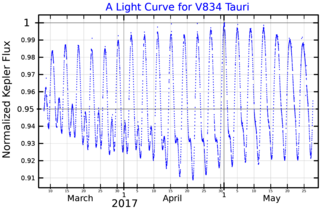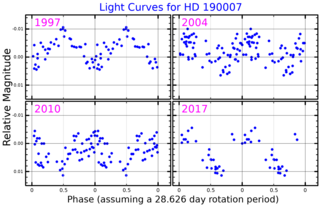HD 147513 is a star in the southern constellation of Scorpius. It was first catalogued by Italian astronomer Piazzi in his star catalogue as "XVI 55". With an apparent magnitude of 5.38, according to the Bortle scale it is visible to the naked eye from suburban skies. Based upon stellar parallax measurements by the Hipparcos spacecraft, HD 147513 lies some 42 light years from the Sun.
Chi Scorpii, Latinized from χ Scorpii, is a single star in the zodiac constellation of Scorpius. It has an orange hue and can be faintly seen with the naked eye with an apparent visual magnitude of 5.22. Based upon parallax measurements, this star is around 409 light years from the Sun. The star is drifting closer with a radial velocity of −23.6 km/s.
61 Cancri is the Flamsteed designation for a visual binary star system in the northern constellation Cancer. The pair have a combined apparent magnitude of 6.25, which means 61 Cancri is faintly visible to the naked eye. Based upon parallax measurements, the system is approximately 181 light years away from Earth.

Gliese 105 is a triple star system in the constellation of Cetus. It is located relatively near the Sun at a distance of 23.6 light-years. Despite this, even the brightest component is barely visible with the unaided eye (see Bortle scale). No planets have yet been detected around any of the stars in this system.
94 Ceti is a trinary star system approximately 73 light-years away in the constellation Cetus.

Tau Centauri, Latinized from τ Centauri, is a solitary star in the southern constellation of Centaurus. It is visible to the naked eye with an apparent visual magnitude of +3.86. The distance to this star, based upon an annual parallax shift of 24.85 mas, is 131 light years. There is a 98% chance that it is a co-moving companion of Gamma Centauri; the two stars have an estimated separation of 1.7 ly (0.53 pc).

HD 29697 is a variable star of BY Draconis type in the constellation Taurus. It has an apparent magnitude around 8 and is approximately 43 ly away.
HR 3384 is solitary star in the southern constellation of Pyxis. It has an apparent magnitude of 6.38, indicating it is faintly visible to the naked eye. Based on the Bortle scale, the star can be viewed from dark rural skies. Astrometric measurements of the star by the Hipparcos spacecraft, give an estimated distance of about 40 light-years from Earth. It is moving away from the Sun with a radial velocity of +81.91.
HD 87822 is a triple star in the northern constellation of Leo Minor. The inner pair orbit each other with a period of about 18 years.
HD 180262 is a wide double star in the equatorial constellation of Aquila. The pair have an angular separation of 89.823″.
HD 35984 is star in the northern constellation Auriga. It has an apparent magnitude of 6.20, which, according to the Bortle scale, indicates it is faintly visible to the naked eye from dark rural skies. Parallax measurements by the Hipparcos satellite indicates it lies at a distance of roughly 290 light years away.
Gliese 146 is a K5V class star located in the constellation Horologium. At 44.4 light years, GJ 146 has an apparent magnitude of +8.57. Gliese 146 is also known as HD 22496, HIP 16711, SAO-216392, and LHS 1563.

HD 190007, also known as Gliese 775, is a star in the constellation of Aquila. Its apparent magnitude is 7.48. Parallax measurements by Gaia put the star at a distance of 41.5 light-years away.
Gliese 42 is a star in the southern constellation of Sculptor. It is too faint to be seen with the naked eye, having an apparent visual magnitude of +7.3. The annual parallax shift of 70.56 mas provides a distance estimate of 46 light years. It has a relatively high proper motion, advancing 0.62 arcseconds across the sky per annum, and is moving closer to the Sun with a radial velocity of −13 km/s.

Delta Coronae Borealis, Latinized from δ Coronae Borealis, is a variable star in the constellation Corona Borealis. Its apparent magnitude varies regularly between apparent magnitude 4.57 and 4.69, and it is around 170 light-years distant.
Tau1 Eridani, Latinized from τ1 Eridani, is a binary star system in the constellation Eridanus. It has an apparent magnitude of 4.46, making it visible to the naked eye in suitably dark conditions. This a spectroscopic binary with an orbital period of 958 days. It is located about 46 light years from the Earth. At present, the system is moving away from the Sun with a radial velocity of +26 km/s. About 305,000 years ago, it made perihelion passage at an estimated distance of 30.5 ly (9.35 pc).
Chi Herculis, Latinized from χ Herculis, is a Sun-like star in the northern constellation of Hercules. Based upon an annual parallax shift of 63.16 mas as seen from Earth, it is located 51.6 light years from the Sun. The star is faintly visible to the naked eye with an apparent visual magnitude of 4.59. It has a relatively high proper motion, showing a transverse movement of 0.769 arc seconds per year and is drifting closer to the Sun with a radial velocity of −56 km/s.

50 Persei is a star in the constellation Perseus. Its apparent magnitude is 5.52, which is bright enough to be seen with the naked eye. Located around 21.00 parsecs (68.5 ly) distant, it is a White main-sequence star of spectral type F7V, a star that is currently fusing its core hydrogen. In 1998 the star was named a candidate Gamma Doradus variable with a period of 3.05 days, which would means it displays variations in luminosity due to non-radial pulsations in the photosphere. Subsequently, it was classified as a RS Canum Venaticorum and BY Draconis variable by an automated program.
Gliese 251, also known as HIP 33226 or HD 265866, is a star located about 18 light years away from the Solar System. Located in the constellation of Gemini, it is the nearest star in this constellation. It is located near the boundary with Auriga, 49 arcminutes away from the bright star Theta Geminorum; due to its apparent magnitude of +9.89 it cannot be observed with the naked eye. The closest star to Gliese 251 is QY Aurigae, which is located 3.5 light years away.
ω Leonis, is a star system located in the zodiac constellation of Leo. It is visible to the naked eye in the absence of light pollution, with an apparent visual magnitude of about 5.4. The distance to this star, as determined using parallax measurements, is around 108 light years from the Sun. Because of its location close to the ecliptic, it is subject to being obscured by the Moon, and potentially by planets.





